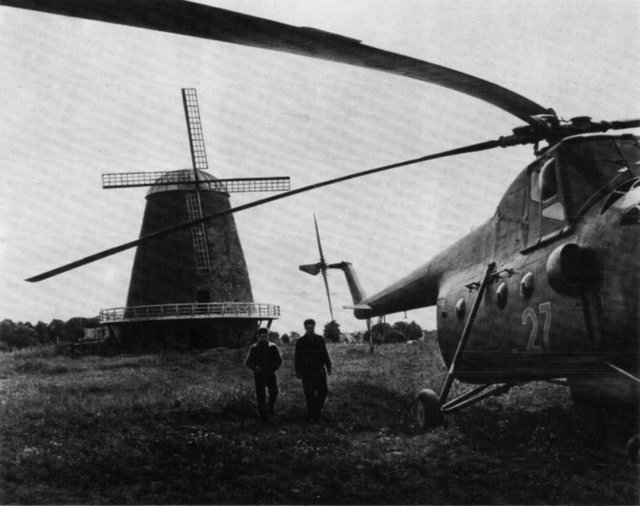The story of a Windmill (featuring Vasily Peskov as author)
There was a stone windmill in Lithuania, and only the wind knew how old it was. The stones were covered with moss, and burdocks grew among them. For many, many years there was no smell of flour inside the mill, nothing but dust collected by the wind on its journeys and brought in through the cracks under the roof.
Yet, the windmill was young once, and winds from all four corners of the earth blew over it. Every wind brought new joy. At the first gusts wagons would come creaking along the roads and men and horses would gather at the mill. The men sang songs, argued, laughed and carried in the heavy sacks of grain. The miller, dusted white with flour, would turn the vanes, facing them into the wind, and then the mill would give forth fragrant white flour to be used for bread and pies. A hundred men could not have turned the huge millstone, but the vanes did. The wind, born of the sea and fated to die in unknown parts, passed on some of its strength to the mill. It was strong enough to turn the vanes of many mills. They all stood atop high hills and would begin turning the moment the wind began to blow. It seemed then as if they were waving to each other, inviting each other over. But all was still when there was no wind. No wagon wheels creaked, nor did the big wooden cogs in the mill. Then the miller would set out for town, leaving the mice to scamper about in the dark, gnawing on grains of wheat. But as soon as there was a breeze everything would come to life again.

Then something happened. Less and less wagons carrying sacks of grain came here. The miller would often hang a padlock on the floured white door and go off to his farm. Then there came a day when the wind was blowing hard, but no one came to the mill. There was not a single horse on the hill, not a single farmer in sight. The miller did not even show up to open the door. For many years after the wind whistled in the vanes forlornly. There were days when the windmill wondered why the tillers had stopped sowing grain. But no, each autumn there were yellow strips of ripe barley and wheat on the hills as always. And a traveller stopping by the mill to rest in the shade would take a loaf of bread from his sack. One quiet day, when the air was so still you could hear mosquitoes droning, the mill heard a strange sound coming from a distance: "put-put, put-put, put-put". It was a motor chugging in the glen beyond the village. Men were arguing and laughing at the steam-powered mill, where the white stream of crushed grain poured forth from the millstones. That day the old windmill realized there was no hope left.
Its old friend the wind began slowly chipping off bits of its vanes and blowing the lime out from between the stones. Its neighbors, the other windmills, began disappearing one by one as the years went by. One was torn down for firewood and some boys accidentally set fire to another. A third burned down during the war. At last, there was only one windmill left on the hills, the one built of stone. People still referred to the old tower as a windmill, but only through force of habit, for what windmill has no vanes or sails?
There were fewer and fewer horses on the roads and more and more horseless carriages. One day, and here the old mill could not believe its eyes, an iron windmill flew by overhead, its slats turning ever so quickly. "I must be dreaming. Windmills can't fly," the old mill said to itself. How could it know that people had put a windmill's vanes to new use? But they were not turned by the wind, they were turned by a motor. The new "mill" could hang suspended over the earth and could fly in any direction. It must have had some business to attend to beyond the hill, for once a month and sometimes more frequently it would appear, zooming over the fields like a dragonfly. Meanwhile, the old windmill kept getting older and older.
One day someone said anxiously that the hills and the road would seem so much duller if the last of the windmills were to disappear. Soon after the key screeched in the old lock. Then the windmill overheard the following conversation:
"We'll have three floors. Beer and kvass will be served downstairs...
"We'll have a staircase to the second floor. Visitors can relax here and order blini."
"We'll have tables on the top floor, too. For those who aren't in any special hurry."
After a while the windmill was given a new set of vanes. A truck began delivering bricks for the railed walk around it. A carpenter and an interior decorator were busy working inside. Soon a hungry traveller will be able to stop here for a glass of cold kvass, fresh apples and cucumbers in summer and hot tea in winter, and, always, a steaming plate of blini. And if he looks out from the brick walk he will see the road, the strips of barley and wheat curving over the hills and the wooded islands among them.
Thus, the old windmill will always be a part of this ancient land.
If you ever happen to be near the village of Seduva in Lithuania you will see the mill from the road. And if you order kvass, raise your mug to toast the old and the new vanes and the health of those who know how to preserve what beauty there is on earth.